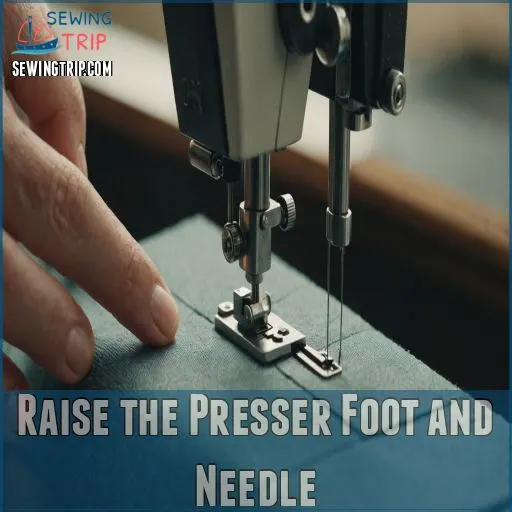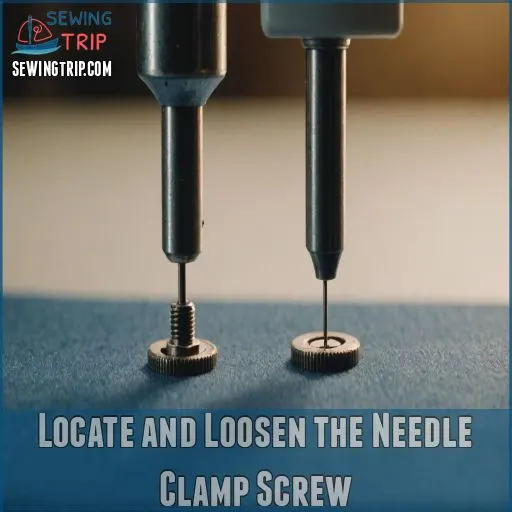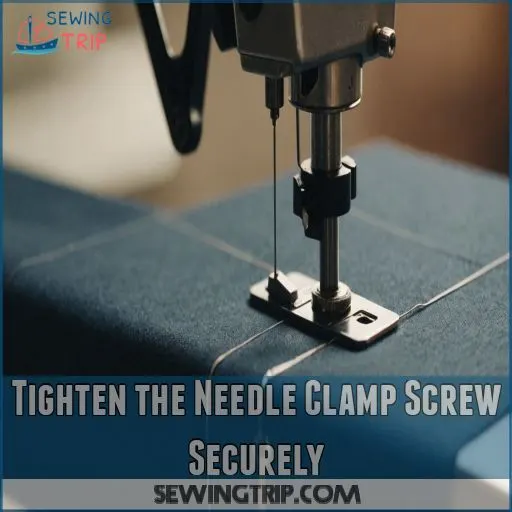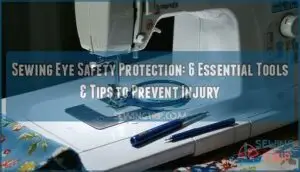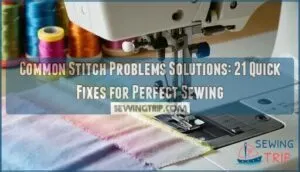This site is supported by our readers. We may earn a commission, at no cost to you, if you purchase through links.
 Changing your sewing machine needle is a breeze once you know the ropes. First, power down and unplug your machine – safety first! Then, raise the presser foot and locate the needle clamp screw. Loosen it up with the right screwdriver, and gently pull out the old needle. Inspect it for any damage before tossing.
Changing your sewing machine needle is a breeze once you know the ropes. First, power down and unplug your machine – safety first! Then, raise the presser foot and locate the needle clamp screw. Loosen it up with the right screwdriver, and gently pull out the old needle. Inspect it for any damage before tossing.
Now, grab your new needle and make sure it’s the right size and type for your project. Slide it in with the flat side facing the back, and tighten that screw back up.
Lower the presser foot, rethread, and give it a test spin on some scrap fabric. Easy peasy! Now, let’s explore some more advanced needle tips…
Table Of Contents
- Key Takeaways
- Turn Off and Unplug Your Sewing Machine
- Raise the Presser Foot and Needle
- Locate and Loosen the Needle Clamp Screw
- Remove the Old Sewing Machine Needle
- Select the Appropriate New Needle
- Insert the New Needle Correctly
- Tighten the Needle Clamp Screw Securely
- Lower the Presser Foot and Rethread
- Perform a Test Stitch on Scrap Fabric
- Maintain Your Sewing Machine Needles
- Frequently Asked Questions (FAQs)
- Conclusion
Key Takeaways
- Always unplug your sewing machine before changing the needle—proper needle maintenance is key; safety first
.
- Use the right screwdriver to handle the needle clamp screw gently; think of it like loosening a jar lid, not cracking a safe.
- When inserting the new needle, make sure the flat side faces towards the back, kind of like ensuring your shoes point forward before running.
- Test your new needle on scrap fabric to avoid stitch surprises; it’s like taking a new car for a spin around the block before hitting the highway.
Turn Off and Unplug Your Sewing Machine
Before switching out your sewing machine needle, make sure the machine is turned off and unplugged to prevent accidental starts.
This simple step protects you and prepares your workspace for a smooth needle change.
Safety Precautions
To avoid accidents during sewing machine needle replacement, always turn off and unplug your sewing machine.
This makes sure you stay safe from unwanted starts while handling sharp objects.
Clear your work area, making sure you have proper tools and eye protection.
Also, practice proper needle disposal and safe storage for a clutter-free, efficient workspace, minimizing risks and maximizing precision.
Preventing Accidental Starts
You’ve considered safety precautions; now focus on preventing accidental starts.
Turn off and unplug your sewing machine to avoid any unexpected jolts.
Safety switches, childproofing, and machine lockouts play a role, but the power cord safety can’t be ignored.
With electrical concerns out of the way, the sewing machine needle change process becomes much safer.
Preparing the Workspace
How do you make sure your workspace is as safe as it’s organized? Start by turning off and unplugging your sewing machine. This simple step prevents accidental starts and ensures safety.
Keep essentials ready:
- Safety Gear: Protects you while working.
- Good Lighting: Helps you see clearly.
- Clean Surface: Avoids clutter and enhances focus.
Raise the Presser Foot and Needle
To change the needle, start by raising the presser foot and needle to access the needle area easily.
Creating space for needle removal helps to position it properly, making the process straightforward and hassle-free.
Accessing the Needle Area
Start by raising the presser foot to access the needle area effectively; it’s like giving your sewing machine a friendly stretch.
With the presser foot up, the needle bar height is just right. This makes it easy to get to the sewing machine needle, needle clamp, and needle clamp screw.
Different presser foot types fit various machine variations, so know yours.
Creating Space for Needle Removal
To create space for needle removal, first raise the presser foot using the lever on the side of your machine.
This lifts the foot and provides clearance around the needle, making it easier to grasp and pull out.
With the foot raised, you can now access the needle and prepare to replace it, which provides an opportunity for needle removal.
Proper Positioning for Needle Change
Easily approach the needle change by creating space.
Next, focus on positioning correctly:
- Raise the presser foot, enhancing visibility.
- Elevate the needle bar to release tension.
- Gently turn the handwheel until the needle is at its highest point.
- Make sure the flat side of the needle shank faces the needle clamp properly.
This avoids skipped stitches.
Locate and Loosen the Needle Clamp Screw
With the presser foot raised, your next step is to locate the needle clamp screw on the needle bar.
Grab a mini screwdriver, which will help you loosen this screw just enough so you can safely remove the old needle.
Identifying the Needle Clamp
Looking at your sewing machine, find the needle clamp near the needle shank, where it holds the needle steady.
Be sure to check the screw for damage before inserting and securing the needle, as a cracked or stripped screw can cause the needle to fall out frequently.
The clamp screw size varies but is usually small, needing careful handling, such as tightening it gently with a coin rather than over-tightening with a screwdriver.
Turn the screw slightly with your fingers to check if it’s the right fit before using a tool.
Regularly check for any clamp problems to make sure sewing goes smoothly.
Using the Correct Screwdriver
When changing a sewing machine needle, using the correct screwdriver is important. First, identify the needle clamp screw.
- Select the Right Type: Flathead or Phillips may be needed. Size matters for grip.
- Proper Grip: Hold the screwdriver firmly.
- Avoiding Damage: Align properly to prevent stripping.
This helps you effectively maintain your sewing machine by following these cleaning and maintenance tips
.
Proper Loosening Technique
Feel like a pit crew member as you approach the needle clamp screw.
Select the right screwdriver that fits snugly and rotate it with right-hand motion.
Avoid over-tightening by gently turning, just enough to release the sewing machine needle.
Experiment with loosening technique variations, ensuring safe handling to prevent stripping the screw head.
Remove the Old Sewing Machine Needle
To safely remove the old sewing machine needle, hold it firmly and pull it straight down with care.
Before discarding, inspect the needle for any bends or damage, which might have contributed to stitch issues.
Grasping the Needle Safely
Now that you’ve loosened the needle clamp screw, it’s time to carefully grasp the old needle.
Use your thumb and forefinger to gently grip the needle, avoiding the sharp point. This will allow you to safely pull the needle straight down and out of the machine. Be mindful of your fingers – needles can be tricky!
- Needle safety tips
- Tweezers for grip
- Needle disposal
- Sharp needle handling
- Safe needle removal
Pulling the Needle Straight Down
Carefully, pull the old sewing machine needle straight down after loosening the clamp screw.
It’s important to use your fingers or needle-nosed pliers if necessary for a safe removal technique.
Make sure the needle doesn’t fall into the machine, which can be tricky to retrieve.
By doing so, you’re practicing excellent needle removal safety and ensuring smooth future sewing sessions.
Inspecting the Old Needle
As you pull the needle straight down, it’s time to inspect the old needle.
- Needle condition: Look for bending or other damage signs, such as snags or holes in the fabric, which can be caused by a dull needle. A dull needle can also lead to uneven stitches and fabric distortion, so it’s essential to check for these signs of wear.
- Wear patterns: Examine the needle for uneven wear.
- Point sharpness: Run your finger cautiously along the tip. Recognizing the Signs of a Dull Needle can help you identify when it’s time for a replacement.
This helps make sure future sewing projects go smoothly. Consider watching a sewing machine needle video for more tips.
Select the Appropriate New Needle
To select the right sewing machine needle, consider the fabric type and the needle size required for your project.
Make sure the needle is in good condition to avoid any sewing mishaps.
Choosing the Right Needle Size
Choosing the right needle size is key for your sewing project’s success when selecting the right sewing machine needle type
. Use a needle size chart to match the needle to your fabric weight, stitch type, and project needs, ensuring suitable needle strength.
For example, size 60 needles are suitable for silk, while size 70 needles are more suitable for cotton. Understanding the nuances of sewing machine needle chart will also help you make the right choice.
Here’s a quick guide:
| Fabric Weight | Recommended Needle Size |
|---|---|
| Light | 70/10 to 80/12 |
| Medium | 90/14 |
| Heavy | 100/16 to 110/18 |
Select wisely!
Matching Needle Type to Fabric
When matching needle type to fabric, consider these four key elements:
- Needle Size: Choose based on fabric weight. A smaller size suits light fabrics, while a larger size handles thicker materials.
- Fabric Type: Distinguish between knit vs. woven.
- Needle Point Type: Use ballpoint for knits, sharp points for woven.
- Thread Type: Match with appropriate needle.
Verifying Needle Quality
After matching your needle type to the fabric, make sure you’re picking a really good needle for your project.
Check for needle sharpness and any signs of needle damage or rust.
Make sure the point type fits your task, and choose the correct needle size for your fabric.
Remember, a damaged needle can spoil your work.
Insert the New Needle Correctly
Inserting the new needle correctly is very important for your sewing project.
Make sure to orient the flat side of the needle facing the back of the machine, then push it all the way up until it reaches the needle bar’s stopper.
Orienting the Flat Side
Attaching the new needle involves aligning the flat side with the back of the needle bar. This orientation makes sure proper needle plate alignment, helping smooth machine threading and great stitch quality.
Before proceeding, you need to inspect the area around the presser foot and clear any clutter, cleaning and inspecting the space to make sure a smooth process.
It’s like matching puzzle pieces—secure the flat side snugly facing back to avoid skipped stitches and make sure everything runs as smooth as silk.
Pushing the Needle Fully Upward
Firmly grasp the new needle; pushing it fully upward makes sure proper needle insertion depth.
Your three essential steps are:
- Needle alignment with the needle bar to prevent needle bar friction.
- Engage the needle stopper function for added security.
- Confirm needle clamp pressure is sufficient to hold it snugly.
These steps enhance sewing precision and protect your machine’s health.
Aligning With the Needle Bar
While aligning the needle with the needle bar, make sure the flat side faces the back. Slide it up until it stops, maintaining focus on needle bar alignment. This prevents needle bar issues.
Check that the needle bar height and function are correct.
For quick reference, consider this table:
| Step | Action | Tips |
|---|---|---|
| Orientation | Flat side back | Firm grip needed |
| Insertion | Push to stopper | Feel a gentle click |
| Adjustment | Align with needle bar | Double-check height |
Following these steps ensures smooth sewing.
Tighten the Needle Clamp Screw Securely
Once you’ve inserted the new needle, it’s important to tighten the needle clamp screw securely to keep the needle stable during sewing.
Be careful not to overtighten, as this can damage your machine.
But make sure the needle doesn’t wobble or shift.
Proper Tightening Technique
After inserting the needle correctly, make sure it stays put by securing the needle clamp screw.
Use the right screw size and apply steady clamp pressure. A small tightening tool, like an eyeglasses screwdriver, is perfect.
This method enhances needle stability without over-tightening risks. Firm but gentle works wonders for keeping everything in place (Source).
Avoiding Over-tightening
Don’t crank that needle clamp screw too tight. You might end up damaging the needle holder, similar to what happens when the needle clamp screw is loose and causes the needle to fall out.
This can be avoided by ensuring the needle is properly installed, with the flat side facing the back and pushed up as far as it will go before tightening the screw. Common causes of needle issues should be considered to prevent damage to your machine.
Instead, tighten it just enough to keep the needle secure – a gentle twist should do the trick. Over-tightening can strip the threads or even crack the plastic. Take it slow and avoid using tools that could apply too much force.
Checking for Needle Stability
To make sure needle stability, securely tighten the needle clamp screw. Give the needle a gentle wiggle to check for any wobble.
Proper needle alignment is very important, so make sure it’s firm, with no unwanted needle movement.
Run a quick needle wobble test by turning the hand wheel; watch for smooth motion without obstruction (Source).
Lower the Presser Foot and Rethread
Lowering the presser foot and rethreading your machine makes sure everything is back in place for smooth operation.
Make sure to adjust your thread tension so your stitches are neat and consistent.
Returning the Machine to Normal Position
With the needle securely in place, gently lower the presser foot to its usual position, ensuring proper presser foot alignment. This step is key for smooth sewing operations.
Next, clean off any stray threads or dust around the needle plate, a small but important part of sewing machine maintenance.
Now, check the thread tension to prevent future stitching issues.
Rethreading the Machine Properly
After lowering the presser foot, carefully follow the threading guide to rethread your machine.
Make sure the thread path is correct, looping through the tension disks and threading guide.
Insert the thread through the needle’s eye, keeping the needle type in mind for compatibility.
Don’t forget the bobbin tension; it ensures even stitching as you begin to sew.
Adjusting Thread Tension
You’ve rethreaded the machine, now it’s time to tackle thread tension problems. Lower your presser foot, close those tension discs, and get ready for some tension troubleshooting.
Here’s how to adjust:
- Set tension dial to the default setting.
- Conduct tension testing with scrap fabric.
- Make tension adjustments in small increments.
- Observe results for tension calibration.
Track down perfect stitches!
Perform a Test Stitch on Scrap Fabric
Testing your needle setup with scrap fabric makes sure everything is working as it should, saving you from any stitch surprise later.
This important step lets you verify needle installation, check stitch quality, and troubleshoot any common issues before starting your project.
Verifying Proper Needle Installation
Now it’s time to verify that your new needle is properly installed.
Perform a test stitch on a scrap of fabric to check for any issues. Look for signs of needle wobble, uneven thread tension, or needle breakage. If everything looks good, you’re ready to start sewing your project!
| Observation | Potential Issue | Recommended Action |
|---|---|---|
| Needle Wobble | Improper Needle Alignment | Reinsert Needle and Tighten Clamp Screw |
| Uneven Thread Tension | Incorrect Needle Depth | Adjust Needle Position in Needle Bar |
| Needle Breakage | Damaged or Incompatible Needle | Replace Needle with Correct Size and Type |
Checking Stitch Quality
Test your new needle by stitching on scrap fabric.
Check for stitch consistency, skipped stitches, and thread breakage. Make sure the needle size matches the fabric type for best results.
A smooth, even stitch line indicates proper installation. If stitches appear wobbly or uneven, revisit your setup to avoid potential sewing hiccups later on.
Troubleshooting Common Issues
To catch potential issues early, sew a line on scrap fabric. This helps to identify any problems before they become major issues.
Before anything else, make sure tension settings are correct to avoid thread jams or fabric puckering.
Look for skipped stitches or uneven seams indicating needle breakage or misalignment.
If issues persist, check the needle size and type for compatibility with the fabric to achieve excellent results.
Maintain Your Sewing Machine Needles
Taking care of your sewing machine needles helps you get smooth stitching.
Regular inspections, proper storage, and a consistent replacement schedule prevent issues like skipped stitches and fabric snags, which prolongs your machine’s life.
Regular Needle Inspection
Ever considered how often you should inspect your sewing machine needle for wear? Regular checks can prevent fabric damage and make sure top stitch quality.
Here’s how to inspect:
- Examine for bent tips.
- Feel for rough spots.
- Confirm stitch consistency.
- Check thread compatibility.
This routine maintains needle types and optimizes performance, giving every project a smooth finish.
Proper Needle Storage
Proper needle storage preserves your sewing tools and boosts your creative endeavors.
Organize needles in labeled containers to prevent rust and confusion. Detect damage by inspecting before storage. Identification is easy with clear labels on sizes and types.
Here’s a quick guide:
| Action | Benefit |
|---|---|
| Labeling | Easy needle choice |
| Container use | Rust prevention |
| Damage check | Increased durability |
| Needle types | Quick identification |
| Organized space | Smooth workflow |
Stay neat, stay efficient!
Establishing a Replacement Schedule
After organizing your needle storage, let’s focus on establishing a replacement schedule.
Regular needle changes help prevent machine wear and guarantee quality stitches.
Replace needles every project or after 8-24 hours of sewing, depending on sewing frequency and fabric type.
Tracking this habit elevates your projects, sparing you from stitch mishaps and prolonging needle lifespan.
Frequently Asked Questions (FAQs)
How do you remove a needle from a sewing machine?
You’ve got a machine ready to sew, yet the needle’s stuck.
First, loosen the needle set screw.
Then, gently pull the needle downwards. Make sure no bits remain inside.
To finish, tighten the screw again.
How do you change a sewing machine needle?
Turn off the sewing machine, then raise the needle to the highest position.
Loosen the needle screw, remove the old needle, and insert a new one with the flat side facing back.
Tighten the screw securely.
When should I change my sewing machine needle?
Needles may seem like small fry, but they’re essential.
Change your sewing machine needle every 6-8 hours or when fabrics pucker, stitches skip, or threads break.
Fresh needles guarantee smoother stitching and prevent fabric damage.
What happens if you don’t change your sewing machine needle?
If you don’t change your sewing machine needle regularly, it can become bent or dull, leading to skipped stitches or fabric damage.
This affects stitch quality and may cause frustration during your sewing projects.
How do I change the needle on my sewing machine?
Did you know 90% of sewing issues are fixed by changing the needle, often due to stitch problems
?
Start by turning off your machine, then loosen the needle screw, remove the old needle, insert the new one facing back, and tighten securely.
Which way does the flat side of a sewing machine needle go when being replaced?
You’ll want to insert the sewing machine needle with the flat side facing the back of the machine.
This makes sure the thread fits snugly into the groove and the hook can catch the loop properly.
Why is my sewing machine not stitching after I changed the needle?
Think of your sewing machine as a car struggling to start; issues might include improper threading, wrong tension, or a misaligned bobbin.
Double-check needle installation, threading, and tension settings for a seamless sewing experience .
How to fix a broken needle on a sewing machine?
First, check if the needle broke into pieces, and remove them carefully.
Use a magnet or invert the machine over a cloth and shake gently.
Replace with a new needle, ensuring alignment before sewing (Source).
What are signs a needle needs replacement?
A stitch in time saves nine, so watch for signs like fabric tugging, frequent thread breaks, and uneven stitches.
If your needle snaps or thuds during sewing, it’s time for a change.
How do I clean the machine before changing needles?
Remove the needle, presser foot, and bobbin.
Use small brushes to clear lint and debris.
Check the bobbin case for smoothness.
After cleaning, reassemble parts in reverse order, ensuring everything is secure for the best performance.
Can I use any brand of sewing needle?
You can use any brand of sewing needle with your machine as long as it’s a standard type.
Make sure it’s suitable for your fabric and thread choice to avoid issues like needle breakage, poor stitching, or fabric damage.
How to choose needle size for different fabrics?
Choosing needle size is like selecting the right tool for a magic spell. Lighter fabrics need smaller needles, like 80/12 for sheers; heavier fabrics crave a 100/16 or 110/ Test on swatches first.
What are safety tips for disposing old needles?
Safely store used needles in a sturdy container like an old prescription bottle.
Check with your local recycling program – some accept sharps for proper disposal.
Avoid tossing loose needles in the trash to prevent injuries.
Conclusion
Sewing machine needles are a simple swap, making sure your projects go smoothly.
Just remember to follow these steps every time: power down, carefully replace, and test with scrap fabric. A well-maintained machine means fewer headaches and better sewing experiences.
Keep practicing, and soon you’ll change needles like a pro, enhancing both your skills and your creativity. Needles may be small, but they’re mighty in your crafting arsenal, and make a big difference with a simple swap.


